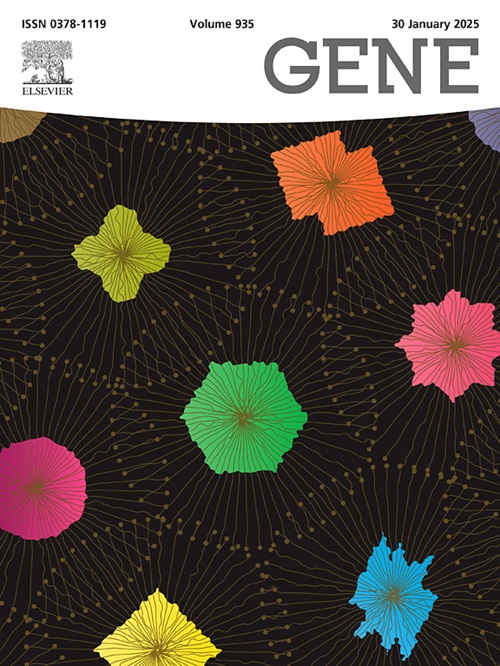Predictive analysis of the impact of probiotic administration during pregnancy on the functional pathways of the gut microbiome in healthy infants based on 16S rRNA gene sequencing
IF 2.6
3区 生物学
Q2 GENETICS & HEREDITY
引用次数: 0
Abstract
Maternal probiotic supplementation altered the microbial composition in infants’ gut, yet its effect on the functional pathways of the microbiota remains unclear. This study aimed to explore the potential impact of maternal probiotic intake on the predicted functional pathways of the gut microbiome in healthy infants. A total of 24 pregnant women were randomly allocated to either the control group or the probiotic group. The women in the probiotic group began receiving probiotics at the 32nd week of pregnancy and continued until delivery. Meconium and fecal samples were collected from infants at birth, as well as on the 3rd day, 14th day, and 6th month after birth. The functional characteristics of the microbial community were inferred using 16S rRNA gene analysis, processed with PICRUSt software, and cross-referenced with the KEGG database. The probiotic group had lower levels of Actinobacteria and Bacteroidetes, while Bifidobacterium growth was notably increased in the infant gut microbiota. At day 0 postpartum, the control group exhibited higher levels of Prevotellaceae compared to the probiotic group (P < 0.05). However, no significant differences were found by day 3. At day 14, the control group exhibited higher levels of Bacteroidaceae and Bacteroides, while Bacteroides_thetaiotaomicron was more abundant in the probiotic group (P < 0.05). By 6 months, the control group showed a higher abundance of Firmicutes (P < 0.05). On day 0 postpartum, maternal probiotic consumption increased the Environmental information processing pathway at KEGG Level 1, and increased Energy metabolism, Metabolism of cofactors and vitamins, and Cell growth and death pathways at KEGG Level 2. It also increased Histidine metabolism, One carbon pool by folate, and Folate biosynthesis at KEGG Level 3. No changes were observed in the infant gut microbiota’s functional metabolic pathways at 3 days postpartum. At 14 days postpartum, probiotics reduced Lipid metabolism pathways at KEGG Level 2 and the Citrate cycle at KEGG Level 3. At 6 months postpartum, probiotics decreased Carbohydrate metabolism pathways at KEGG Level 2. Our findings suggest that probiotic supplementation during pregnancy affects the functional metabolism of the gut microbiota in healthy infants. This, in turn, may influence the development of the infant’s immune system, metabolism, and overall health by modifying the gut microbial environment.

基于16S rRNA基因测序的妊娠期益生菌给药对健康婴儿肠道微生物功能通路影响的预测分析
母体益生菌的补充改变了婴儿肠道中的微生物组成,但其对微生物群功能途径的影响尚不清楚。本研究旨在探讨母体益生菌摄入对健康婴儿肠道微生物群预测功能通路的潜在影响。共有24名孕妇被随机分配到对照组和益生菌组。益生菌组的妇女从怀孕第32周开始服用益生菌,一直持续到分娩。采集婴儿出生时、出生后第3天、第14天和第6个月的胎便和粪便样本。利用16S rRNA基因分析推断微生物群落的功能特征,用PICRUSt软件进行处理,并与KEGG数据库进行交叉比对。益生菌组的放线菌和拟杆菌的水平较低,而双歧杆菌的生长在婴儿肠道微生物群中明显增加。在产后第0天,对照组的普氏菌科水平高于益生菌组(P <;0.05)。然而,到第3天,没有发现显著差异。第14天,对照组Bacteroidaceae和Bacteroides含量较高,而益生菌组Bacteroides_thetaiotaomicron含量较高(P <;0.05)。6个月时,对照组厚壁菌门(P <;0.05)。产后第0天,母体益生菌摄入增加了KEGG水平1的环境信息加工通路,增加了KEGG水平2的能量代谢、辅因子和维生素代谢以及细胞生长和死亡通路。它还增加了组氨酸代谢、叶酸碳库和KEGG水平3的叶酸生物合成。产后3天未观察到婴儿肠道微生物群功能代谢途径的变化。产后14天,益生菌降低了KEGG水平2的脂质代谢途径和KEGG水平3的柠檬酸循环。在产后6个月,益生菌降低了KEGG水平2的碳水化合物代谢途径。我们的研究结果表明,怀孕期间补充益生菌会影响健康婴儿肠道微生物群的功能代谢。反过来,这可能通过改变肠道微生物环境来影响婴儿免疫系统、新陈代谢和整体健康的发育。
本文章由计算机程序翻译,如有差异,请以英文原文为准。
求助全文
约1分钟内获得全文
求助全文
来源期刊

Gene
生物-遗传学
CiteScore
6.10
自引率
2.90%
发文量
718
审稿时长
42 days
期刊介绍:
Gene publishes papers that focus on the regulation, expression, function and evolution of genes in all biological contexts, including all prokaryotic and eukaryotic organisms, as well as viruses.
 求助内容:
求助内容: 应助结果提醒方式:
应助结果提醒方式:


